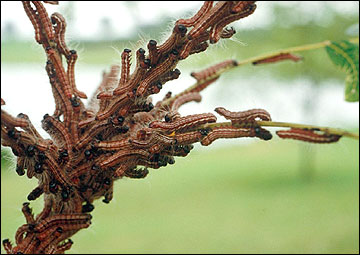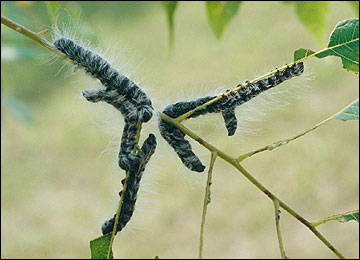Walnut caterpillar
Prominents and oakworms
 Red phase, left, and black phase, below, walnut caterpillars (Datana integerrima) are present from early May to September. They produce one to two generations per year.
Red phase, left, and black phase, below, walnut caterpillars (Datana integerrima) are present from early May to September. They produce one to two generations per year.

Developing caterpillars, 0.5 to 1.5 inches long, have black heads and dark red bodies with several longitudinal white stripes. They are gregarious, feeding and molting together. Often a large mass of hairy, shed skins can be seen attached to a branch or the trunk. Full-grown larvae, no longer gregarious, are nearly two inches long and have a black body covered with long, white hairs. Preferred host plants include walnut, butternut, pecan and hickory. The walnut caterpillar is often a serious pest of walnut.
About the family
Prominents and oakworms belong to the Notodontidae family. Caterpillars have variable color patterns and body texture. Some species are smooth with fleshy humps or projections while others are hairy. Some are cryptically colored, mimicking the edge of a partially eaten, distorted leaf, while others are brightly colored and conspicuous. In some species, when the caterpillars are disturbed, they raise both ends of the body, holding onto the substrate with the four mid-abdominal prolegs and exposing glands that produce irritating acidic chemicals to ward off potential attackers. Caterpillars exhibit both solitary and gregarious behavior. Host plants include a wide variety of trees and shrubs.